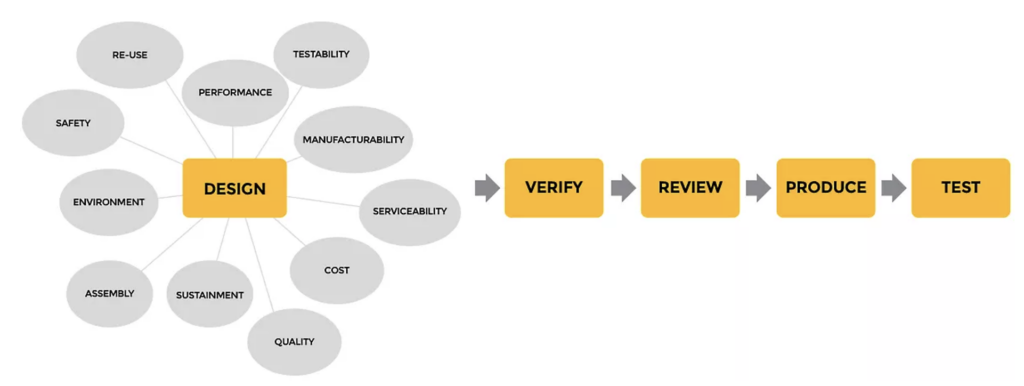The Lean institute say 95% of process activities associated with manufacturing ultimately add no value to the customer and HCL Technologies say 70% of the engineering changes which delay production are due to brands trying to retrospectively correct issues with design to deal with assembly, cost & quality problems.
Apply Best Practices Early and Often
DfX principles can be applied at any time in the product life cycle where design happens, including initial design and redesign. Of course, for any new product introduction (NPI), DfX practices should be implemented as early in the design phase as possible. For a fielded product or a product that is already well into other phases of product development, it’s never too late to consider DfX approaches when the need to redesign comes along.
New product introduction: Due to perceived cost or fears of stifling creativity and innovation, there may be some resistance to implementing DfX in the early concept phase of a design, but it is critical to bring in DfX specialists and lessons learned as early as possible to maximize the benefits. Even in the concept phase, it is important to ask questions like:
- What impact will the design have on reliability?
- Will a new technology need to be invented to make this design a reality?
- What manufacturing challenges does this design pose?
- How will the fielded product be supported?
Although these considerations are far down the line from concept design, they can be crucial to design concept trade-offs and getting the design phase kicked off in the right direction. At the very least, the DfX program should be in full effect before detailed design requirements are established.
Product mid-development: If a product is largely past the design phase but experiences problems in preproduction, test, or manufacturing that require a redesign to address, DfX practices can help ensure that the next redesign will be the last. Applying DfX expertise at this stage helps identify the true root causes driving the redesign and results in a design more suited to being tested, manufactured, assembled, deployed, repaired, etc.
Fielded product: Fielded products that go through redesign as part of a proactive product improvement program or to address field reliability, performance, maintainability, or safety concerns can also benefit from DfX practices. Identifying root causes of any issues and developing the requirements for the redesign are key tasks in which the DfX methodology can have the most impact to minimize the cost and timeline for the redesign effort.
Who Should Be Involved with DfX?
While DfX approaches require the knowledge of experts, successful design teams ensure that everyone on the team understands, implements, and sees the value of the DfX methodology. Successful DfX teams capture and use expert knowledge in the form of design requirements, design rules, and team member training to ensure that everyone on the team is using DfX best practices. For experts to help address novel problems, they should be included at critical design milestones to help identify risk and develop mitigation strategies.
Depending on the size and structure of the organization, job titles may vary, but key participants in the DfX program should have expertise in component selection and sourcing, reliability physics, assembly and manufacturing, test, field support practices and logistics, and use environments and stressors. Depending on the product and its intended use, expertise in areas such as thermal management, applicable environmental regulations, safety, reuse and recycling, and cost management may also be helpful.
DfX Best Practices
Start early. Implementing DfX practices early in the design process produces higher quality products at lower life cycle cost, with shorter times to market. The longer you wait, the less impact DfX will have on the final product.

DfX helps prevent problems early in design, rather than problem solving and redesigning later in the product development process.
People, processes, and tools. Starting from scratch is not easy. A solid DfX program requires:
- People with the right expertise, training, and a continuous improvement mindset.
- Well-documented, easily accessible, and standardized processes that incorporate best practices and lessons learned.
- Standard tools that make implementation of expert knowledge easy for everyone on the design team. In fact, a well-designed DfX program should mean fewer tools in your design process rather than more.
Use only what you need. Depending on who you ask, there are nearly 50 different DfX practices. The good news: You typically only need a few to make a positive impact on your product development process. Design for reliability (DfR), design for manufacturability (DfM), design for testability (DfT), and design for sustainment (DfS) are the most common DfX practices used in the electronics industry. If you are not using a DfX methodology today, consider implementing just one of these proven techniques.
Following these best practices will ensure the final product can be realized at reasonably low life cycle costwhile still meeting reliability, quality, durability, and customer expectation targets.
—
What is Design for Excellence (DfX)?. Ansys Blog. June 21, 2023. https://www.ansys.com/blog/what-is-dfx
Palmer, Nigel. Design for Excellence (DfX) to Improve Product Cost, Quality, and Time to Market. TT Electronics. 2022. https://www.ttelectronics.com/blog/design-for-excellence/
Sharp, Neil. What is Design for X (DfX) in manufacturing? Escatec. July 7, 2022. https://www.escatec.com/blog/what-is-design-for-x-in-manufacturing
Velling, Andreas. Design for X (DFX) Methods. Fractory. June 17, 2021. https://fractory.com/design-for-x-dfx/
Van Tyne, Sean. Easy to Use 2.0: User Experience in Agile Development for Enterprise Software. Crystal Point Media. 2017
Bean, Jeofrey, Van Tyne, Sean. The Customer Experience Revolution: How Companies Like Apple, Amazon, and Starbucks Have Changed Business Forever Paperback. Brigantine Media. 2011